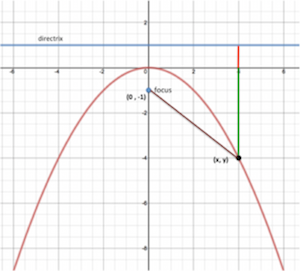Home
Episode 5 Supports
Episode Description
Making Sense: Sasha and Keoni make a prediction about an equation for any parabola with a vertex on the origin.
Students’ Conceptual Challenges
Sasha and Keoni notice a pattern in the denominators of their three equations (y = x2/4, y = x2/8, and y = x2/12); yet they struggle to determine how the pattern is being generated [0:41- 0:50].
- Sasha and Keoni first plot the focus and directrix for each parabola. They then make sense of a pattern that relates the distance between the focus to the vertex to each equation.
- Sasha and Keoni first plot the focus and directrix for each parabola. They then make sense of a pattern that relates the distance between the focus to the vertex to each equation.
Focus Questions
For use in a classroom, pause the video and ask these questions:
1. [Pause video at 0:46]. What have Sasha and Keoni already figured out about the equations of the parabolas?
2. [Pause video at 6:21]. What do you think about Sasha and Keoni’s conjecture? How did they arrive at it?
Supporting Dialogue
Provide an opportunity for students to revoice other student’s ideas in the classroom.
- As students answer Focus Question 2, ask students to revoice the ideas of their classmates.
- As students answer Focus Question 2, ask students to revoice the ideas of their classmates.
Math Extensions
The graph below represents a parabola with a focus at (0, –1) and a directrix at y = 1. A general point on the parabola is labeled as (x, y). The distance between that point and the focus is shown in brown. The distance from the general point to the directrix is represented by the red and green segments together.
1. Can the value of y for any point (x, y) on this parabola be positive? Why or why not?
2. The distance from the point (x, y) to the x-axis (shown by the green segment) is -y. Explain why. Hint: Consider the distance from different points on this parabola, like (2,–1) or (4,–4), to the x-axis.
3. Use the definition of a parabola and the Pythagorean theorem, find the general equation for the parabola. Show your work.

Mathematics in this Lesson
Lesson Description
Targeted Understanding
CC Math Standards
CC Math Practices
Lesson Description
Keoni and Sasha determine a general method for representing the equation for a parabola with a vertex on the origin and a focus p units above the vertex.
Targeted Understandings
This lesson can help students:
- Interpret the meaning and use of an equation that they derive to represent a family of parabolas with vertex at the origin and focus p units above the vertex (y = x2/(4p)).
- Conceive of the parameter p in the equation y = x2/(4p) as a distance between the vertex and focus of a parabola. The value of p can vary, but once it is set (e.g., when p = 2), then an equation is defined (e.g., y = x2/8) that represents a unique parabola.
- Relate geometric features of parabolas to elements of corresponding equations. For example, the equation y = x2/8 can also be expressed as y = x2/(2•4), where the 2 represents the number of units between the focus and vertex of the parabola.
Common Core Math Standards
• CCSS.M.HSG.GPE.A.2: Derive the equation of a parabola given a focus and directrix.
In Episode 6, Sasha and Keoni derive the equation (in two forms) for the family of parabolas with vertex (0,0) and focus p units above the vertex, namely y = x2/(4p) and x = √(4py). They do this by generalizing the method they used to develop an equation for a parabola with p = 1 in Lessons 3 and 4 (y = x2/4 and x = √(4y)), for a parabola with p = 2 in Episode 2 of this lesson (y = x2/8 and x = √(8y)), and for a parabola with p = 3 in Episode 4 (y = x2/12 and x = √(12y)).
• CCSS.M.HSA.APR.A.1: Perform arithmetic operations on polynomials.
Sasha and Keoni multiply binomials, such as (y + 2)2 and (y + p)2, in service of deriving an equation for a particular parabola (in Episodes 2 and 4) or a family of parabolas (Episode 6).
Common Core Math Practices
CCSS.Math.Practice.MP7. Look for and make use of structure.
In this lesson, Sasha and Keoni make use of mathematical structure on two levels. First, they discern a pattern relating the equations of three parabolas (y = x2/4, y = x2/8, and y = x2/12) with the corresponding distance between the vertex and focus (respectively, p = 1; p = 2; and p = 3). Specifically, they see the structure of 1•4, 2•4 and 3•4 in the denominators of their equations, which is the p-value of the parabola multiplied by 4. Consequently Keoni and Sasha conjecture that the general equation of a parabola with vertex (0,0) and focus p units above the vertex will be y = x2/(4p). Then they look for and make use of structure on a second level. To derive the equation y = x2/(4p), they need to identify the lengths of the sides of a right triangle with hypotenuse connecting a general point on the parabola with the focus. To accomplish this challenging task, Sasha and Keoni see a pattern in similar quantities that they identified for particular parabolas, which they generalize to define lengths involving the parameter p, such as y – p and y + p.



















